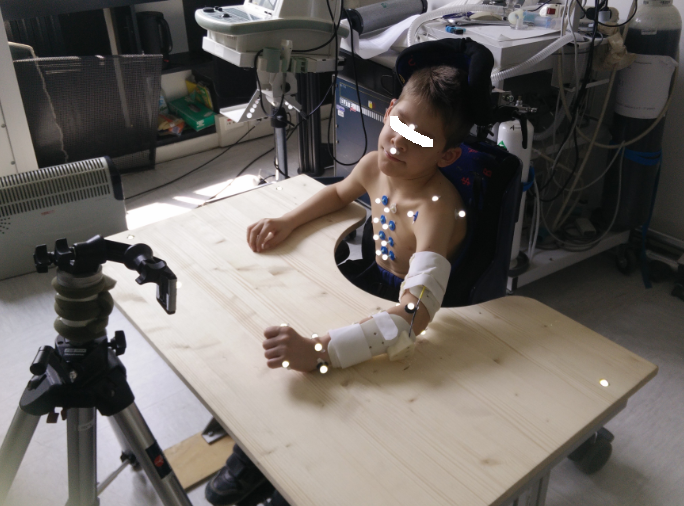Session Information
Date: Thursday, June 8, 2017
Session Title: Pediatric Movement Disorders
Session Time: 1:15pm-2:45pm
Location: Exhibit Hall C
Objective: The study reports preliminary observations on the use of orthotic devices with nonlinear spring properties prescribed with the aim to stabilise posture and improve upper-limb motor control in young patients with Movement Disorders (MD).
Background: Cerebral palsy and other cerebral lesions are at the basis of secondary paediatric MD, carrying along control deficits, ill posture and functional disability. Drugs may be ineffective in some cases and alternative treatments are sought. Viscoelastic force fields are known to affect muscular synergies and may enhance proprioceptive feedback. Orthoses based on pseudoelastic alloys were developed to provide that dynamic action.
Methods: With Ethics Committee’s approval, we recruited five children (12.2±5.6 years old) with complex MD pictures comprising secondary dystonia and dyskinesia of various aetiology. They were evaluated prior to and after a 30-days’ elective treatment with a new functionally-personalised orthosis. Passive range of motion, Modified Ashworth Score and motor function (Melbourne Upper-Limb Scale) were evaluated. The subjects also carried out the reach-forward and hand-to-mouth tasks under optoelectronic monitoring (figure 1), and upper-limb kinematics was analysed. PedsQL was used to assess patients’ perceptions about the therapy, and anecdotal observations were recorded.
[Figure 1]
Results: The orthotic treatment was very well accepted. There were no adverse effects. Clinical results differed according to the main trait, with prevalently dystonic patients improving more in the postural domain, and dyskinetic ones developing better movement stability with segmental kinematics becoming more task-related. One dyskinetic patient obtained promising results also during daily activities, as documented by footages shot at home. In this case, the Melbourne Scale score improved from 7.3% to 16.4%.
Conclusions: The current study does not possess statistical generality. The patients, taken singularly, did display improvements in life quality as a correlate of better posture, less pain and better functional abilities in some domains. The overall improvement was mild; patients’ perception was good. The preliminary clinical impressions support an indication for pseudoelastic devices, as adjuvant in the treatment of MD in the young, but longer treatment durations and larger cohorts, are needed to confirm efficacy.
To cite this abstract in AMA style:
L. Garavaglia, E. Pagliano, M.T. Arnoldi, R. Zanin, M.A. Lo Mauro, G. Baranello, A. Aliverti, S. Pittaccio. Pilot evaluation of pseudoelastic orthoses for supporting motor control in children with secondary dystonia and dyskinesia [abstract]. Mov Disord. 2017; 32 (suppl 2). https://www.mdsabstracts.org/abstract/pilot-evaluation-of-pseudoelastic-orthoses-for-supporting-motor-control-in-children-with-secondary-dystonia-and-dyskinesia/. Accessed December 30, 2025.« Back to 2017 International Congress
MDS Abstracts - https://www.mdsabstracts.org/abstract/pilot-evaluation-of-pseudoelastic-orthoses-for-supporting-motor-control-in-children-with-secondary-dystonia-and-dyskinesia/

